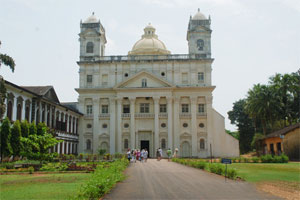St. Cajetan Church

St. Cajetan Church is situated to the south of the Viceroy's archway, It was erected in 1661 by Italian friars of the Theatine Order, in the style of the famous Basilica of St. Peter in Rome. Originally called The Church of Our Lady of Divine Providence it was built of laterite blocks and named after the founder of the Theatine Order, St. Cajetan.
Besides the main altar that is dedicated to Our Lady of Divine Providence, the St. Cajetan church has six Baroque style gilded altars which have figures of angels dominating twisted shafts. To the left the three altars are dedicated to St. Clare, the Holy family and Our Lady of Piety whereas those to the right are dedicated to St. Agnes, St. John and St. Cajetan. Scenes from the life of St. Cajetan are depicted by the Italian school paintings on canvas on the altars. A covered well, supposed to be the remnant of a Hindu temple exists on the church floor.
A basalt doorway is situated within the church compound that consists of what is considered to be the only left relic of Adil Shah's palace - two decorated pillars set on a stepped plinth. The doorway however has carvings of Hindu deities and according to Percival Noronha the heritage expert it was bought in 1930 and is a part of the Kadamba era Ganesha temple that existed at the Divar Island.




